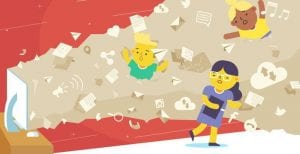I recently read an article by Elizabeth Mulvahill on the website We Are Teachers posted on August 28, 2018 and have excerpted it below.
“There is an infinitely greater amount of information available to our students than we ever had to deal with.
Think about it, you can find the answer to any question you have about practically any topic in the world in seconds via technology. The problem is, there’s SO much information available, it can be overwhelming. How do you discriminate between what’s important and what’s fluff? What’s true and what’s baloney? How do you know what sources to trust and where to look for proof? Learning to evaluate and prioritize information quickly and efficiently is one of the most important life skills we will ever teach our students.
In addition, with the landslide of information available, it may seem to our students like everything’s already been said. Our challenge is to teach them to sort through and use the best information to create original works and solve problems in innovative ways.”
At Spofford Pond School, a significant portion of students’ Library Media classes are dedicated to Information Literacy. Students will be learning how to use trustworthy sources, apply effective search strategies and to look critically at the information they find in order to create understandings.
“In the complex technological world of today, education is no longer simply the acquisition of a body of knowledge. It is rather the ability to continually access and use a
vast array of information sources. The learner must be able to effectively evaluate these sources, combine them in meaningful patterns and react creatively to the results.
For a successfully educated individual, this mode of learning becomes a lifelong habit, since knowledge acquired today may be inadequate tomorrow, while the process of
searching out answers, once learned, will be a lifetime skill.”
—Rationale for Today’s School Library Media Center, MSLA


